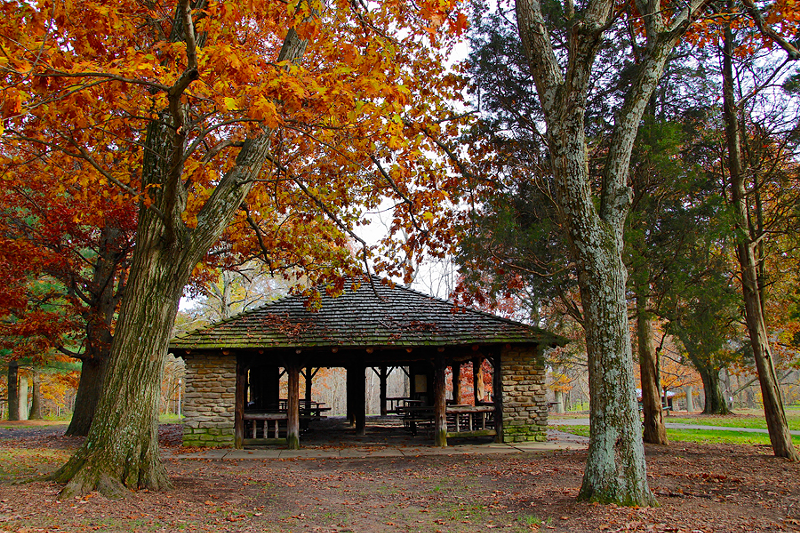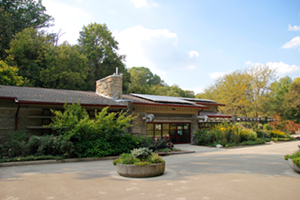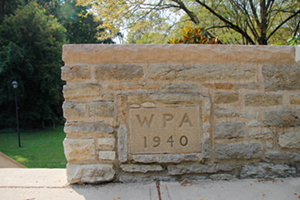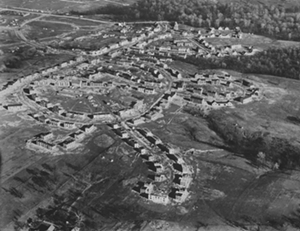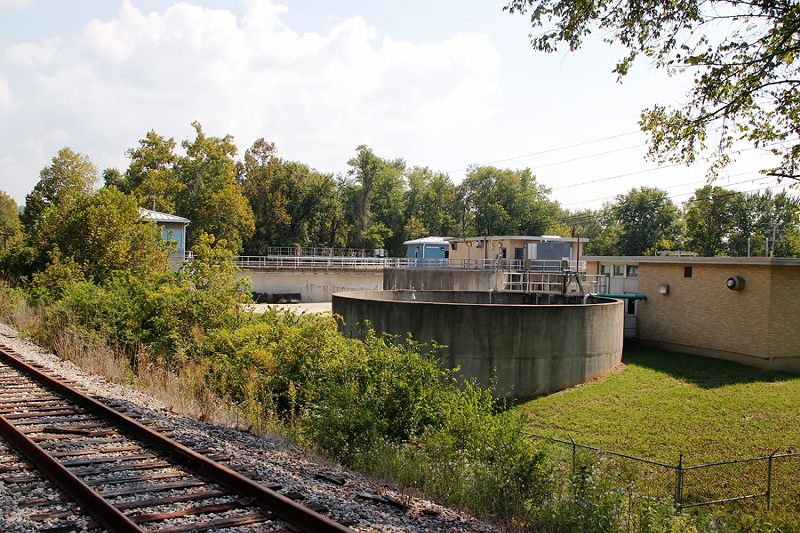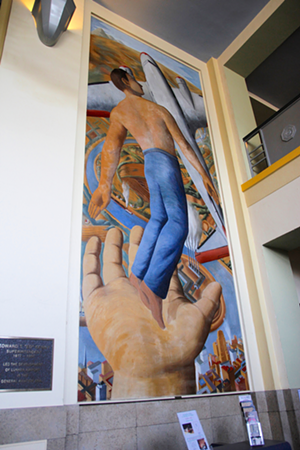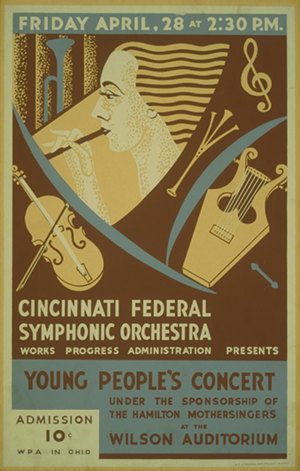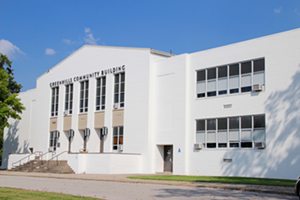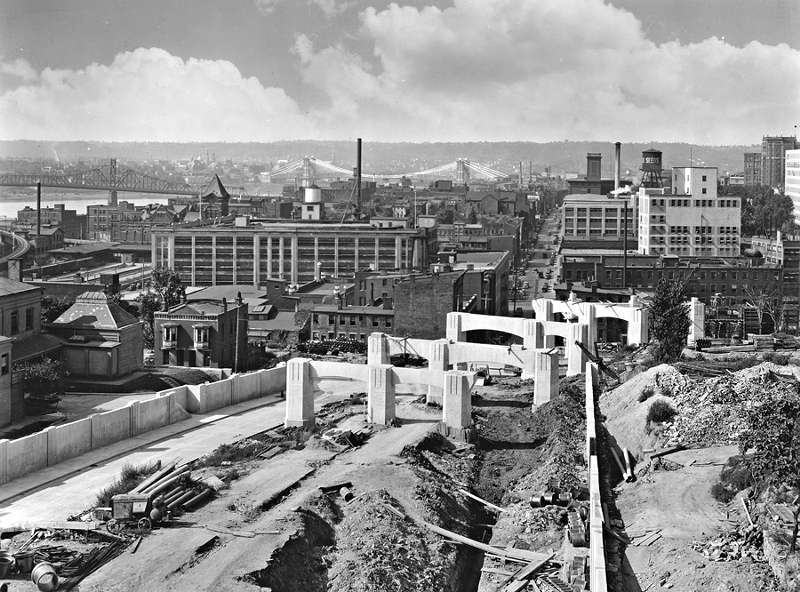
As the region and the nation as a whole mull everything from how to replace bridges to sprucing up public parks, it’s worthwhile to look back at one of the nation’s largest and most wide-reaching investments in public works 80 years ago.
The Works Progress Administration and other New Deal programs instituted by President Franklin Delano Roosevelt in the 1930s left an indelible mark on the region, giving us a major parkway just east of downtown Cincinnati, an entire town just north of the city, a landmark urban forest and iconic architecture in parks across the city.
The New Deal was a response to the worst economic depression in the nation’s history, brought about by the 1929 stock market crash. As such, it was primarily a jobs program meant to put people back to work, including thousands of otherwise unemployed Cincinnatians. And it was successful by that count — New Deal programs employed more than 8 million people, including thousands in Cincinnati, during the Great Depression. But its legacy has lasted much longer than a few years of gainful employment.
Efforts under the New Deal started in the early 1930s but really took off with the creation of the Works Progress Administration in 1935. The federal government pumped millions into local economies with buildings and other stimulus projects. As it did, it created physical embodiments of the ideologies of the time, a worldview that was at once both collective and deeply segregated.
“All of this spending represents a moment in time dealing with an emergency, but also represent what peoples’ thoughts were on what housing should look like, what roads should look like, what parks should look like, what post offices should look like,” says David Stradling, a University of Cincinnati history professor. “We created, all of a sudden, in a big burst, a world that has that sleek modern look to it.”
Those efforts went beyond roads and bridges. New Deal programs funded some of the nation’s first public housing projects, new experiments in urban planning and a gamut of cultural production from artists, writers, photographers and more.
Not everything about the New Deal was admirable. Those housing projects were segregated when they were built. Indeed, most New Deal programs were created first and foremost to help white men over other groups struggling with the Depression. Though some blacks — mostly Civilian Conservation Corps members — were employed by FDR’s programs in Cincinnati and about 1,000 female tailors received work through the programs repairing damaged clothing for the poor, for the most part the programs were highly segregated by race and gender.
“That’s absolutely a theme of the New Deal that follows common practice at the time — to help whites first, to help men first,” Stradling says. “It was even more lopsided gender-wise than it was race-wise. It gives you a sense of what their priorities were — who they thought should get back on their feet first.”
It wouldn’t be the last time the federal government stepped in with big plans and big money, says Anne Delano Steinert, Over-the-Rhine Museum board chair and a historian who researches the New Deal. Highway construction and urban renewal in the 1950s and 1960s also made a huge, not-always-positive impact.
But the New Deal represents a uniquely pivotal moment that left high water marks all across Greater Cincinnati. Despite its legacy of segregation, New Deal programs gave us durable monuments to public investment that thousands of Cincinnatians still use and enjoy today.
Columbia Parkway

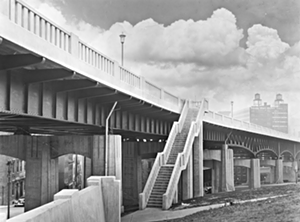
One of Cincinnati’s largest and most recognizable roads is a product of the New Deal. Though U.S. Route 50 east of downtown predates the Depression — drawn on roughly its current route through eastern Ohio into West Virginia in 1926 — the program’s Public Works Administration built the grand, elevated Columbia Parkway that carries Route 50 through Cincinnati throughout the late 1930s.
The riverside highway’s Art Deco retaining walls and abandoned staircases, which the city sealed in the early 2000s, are a vestige of the project and the era. It now carries an average of 18,000 cars a day, according to data from the Ohio, Kentucky and Indiana Regional Council of Governments.
“That part of Columbia Parkway that we think of as iconic, that’s a New Deal project,” Stradling says. “For a lot of it, they weren’t even working on existing road. They were blazing through the steep hillside (where Mount Adams and other neighborhoods are). They’re moving a lot of earth.”
The project eliminated a number of existing roads and structures in the area north of the river but south of the hills where Mount Adams and other neighborhoods are. You can still see the remnants of some of those streets today in the short stubs that run up from the Parkway.
The Parkway’s origins illustrate a common phenomenon for New Deal projects — the thoroughfare was part of a 1920s plan for Cincinnati’s parkways that long predated the federal program.
“That’s not unusual for the New Deal altogether,” Stradling says. “If you’re wanting to spend money, what are the projects? You don’t sit down in a room and start imagining things. You go out and say, ‘What have we been trying to build?’ ”
Mount Airy Forest
Like Columbia Parkway, the vision for Mount Airy Forest itself predates the New Deal. Famed park planner George Kessler drew up plans for the first municipal reforesting effort in the country in 1907 and the city began planting it in 1911.
But the urban forest received a very significant boost under FDR’s programs. In partnership with the National Park Service and the Cincinnati Park Board, members of the Civilian Conservation Corps (CCC) built the majority of the shelters, stair sets, dams and other structures in the park and performed much-needed erosion prevention work. They also planted more than one million seedlings and saplings.
Other programs, including the Civil Works Administration and the Works Progress Administration, also chipped in work at the forest. New Deal work in Mount Airy was so extensive that CCC workers lived on-site in long bungalows, one of which still stands today in an off-limits part of the park.
Elsewhere in the country, the CCC was a mostly rural program. That wasn’t the only element of New Deal work in Mount Airy that was unusual. The first CCC crew to arrive to work on the park in 1935 was a group of 20 young black men. Their first task, completed in a few weeks, was to construct the camp they were to live in. Most of the subsequent CCC crews — who eventually put in a cumulative 50,000 days of work on the park — were black. That was an anomaly for New Deal programs.
“It’s a reflection of the segregated federal government at the time,” UC’s Stradling says of the dearth of black workers in the program, noting that the fact the effort was happening in a city with a significant black population probably influenced the demographics of the workers in Mount Airy. “It’s not very typical for CCCs to actually be in the city.”
The work the CCC did was often backbreaking — another reason the program’s organizers might have taken on black workers.
“The work in Mount Airy Forest was incredibly hard, busting open boulders and things,” Steinert says. “It was the kind of work that other people maybe didn’t want to do.”
Today, Mount Airy Forest is the city’s largest park, stretching almost 1,500 acres. Cincinnatians have those Civilian Conservation Corps workers to thank for many of its trees, shelters and stairways.
Parks Architecture
Work on Cincinnati’s parks wasn’t confined to Mount Airy. If you’re an avid Cincinnati park-goer, chances are you’ve enjoyed work funded by the New Deal and carried out by laborers for the Public Works Administration, the Civilian Conservation Corps or other federal programs of the era. In total, New Deal workers built about half of Cincinnati Parks’ 135 existing structures.
Burnet Woods’ beautiful fieldstone Trail Side Nature Museum and the whimsical concrete slide next to it in the heart of the park are two examples. You can easily see the signature workers left behind — a stone and concrete wall with “WPA 1940” etched into it.
You can also find evidence of the New Deal in Eden Park’s stone stairways and its public pool house perched atop a hill next to the Playhouse in the Park. Mt. Echo’s iconic picnic shelter is another prominent New Deal construction. California Nature Preserve, which was established in 1938, gives East Siders a lovely place to bird watch and hike courtesy the WPA.
Many of these projects were already on the city’s wish list prior to the Great Depression. The New Deal, however, provided the money and the manpower to make them happen. The city and Cincinnati Parks likely had wide discretion on what to build and where.
“Sometimes, it wasn’t just the discrete projects,” Stradling says of New Deal spending. “Sometimes, municipalities got a lump grant and they could use it how they wanted. It’s possible the Park Board got money and decided how to spend it.”
Greenhills
One of the New Deal’s most ambitious efforts anywhere in the nation took place just a few miles north of Cincinnati. Greenhills was one of only three so-called “green belt towns” across the country built by the federal Farm Resettlement Agency during the Depression.
Greenhills was meant to be the ideal modern community designed for city dwellers with limited means seeking to escape the noise and grit of urban areas. Its gleaming white buildings and lush green space offered a respite for working class families hit hard by tough economic times.
The federal government enlisted the help of prominent architects and urban planners to draw up designs for Greenhills and carefully picked the residents who were to live there from families in Greater Cincinnati.
“There were all these community functions that were really designed to support this idea of collaboration and community living,” says OTR Museum’s Steinert, who researches Greenhills as a University of Cincinnati Ph.D. candidate.
She also has other ties to the grand New Deal experiment: Her grandparents were among its original inhabitants.
“They were this young, married couple with a baby,” Steinert says of her grandparents. “(The federal government) recruited people like that from all over the Greater Cincinnati area. They moved in starting in 1938, and they really did build that community they were hand-picked to build.”
The center of town featured a towering school building that doubled as a community center. It also boasted a number of collective endeavors that were novel at the time: a cooperative grocery store, one of the nation’s first credit unions and the like.
Steinert says that the community functioned well, forging deep ties between neighbors. When the federal government pulled out in 1943, many residents bought their homes under generous financing terms, and their descendants continue to live there today.
But like many New Deal projects, there was a dark downside. Greenhills was strictly segregated.
“What they did is they really engineered who was going to live there,” Steinert says. “There was this idea, this false dichotomy, that there were deserving poor, and that’s who you were trying to provide this for. The bummer is, that was something that was only available to these hand-picked white families. So it really was an idyllic, dreamy childhood my dad had. But he had it at the expense of other children who couldn’t have it.”
Water & Sewer Improvements
A major, if under-documented, contribution New Deal programs made to Cincinnati has probably been right under your feet, though you wouldn’t know it.
The Works Progress Administration made a number of improvements to the city’s sewer and water infrastructure, installing and updating piping in various locations across the city. In many cases, documentation doesn’t show exactly where the work was done, but does show plenty of money and manpower spent modernizing these vital functions.
“There still were lots of parts of the city that were either rural when they were built or were old and didn’t have sewers when they were planned,” Stradling says. “There wasn’t a whole lot of new housing construction going on, so it was mostly about retrofitting areas that never had sewers, trying to replace septic systems, which, once you get a certain amount of density, become very problematic.”
At least one major vestige of the work New Deal programs did for the region’s water infrastructure remains: a large water treatment facility west of the city limits. The WPA constructed the Indian Creek Waste Water Treatment Plant in North Bend in 1935. After some upgrades through the years, it currently processes more than 1 million gallons of wastewater a day as part of the Metropolitan Sewer District.
Public Art
Beyond brick, mortar and piping, New Deal programs funded numerous creative projects throughout Greater Cincinnati. Sadly, of the hundreds of murals painted, plays written and performed, photographs taken and other creative endeavors launched by efforts to employ artists and writers during the Depression, most are lost today.
A few remain, however, including a pair of murals commissioned by the Federal Art Project at Lunken Airport by artist William Harry Gothard. When you walk into the airport’s lobby, you’re greeted on the left by a two-story mural of a man weighed down by a giant stone symbolizing gravity. On the right, another mural depicts a man soaring through the air above a stylized Cincinnati cityscape — a tribute to the rush of flight.
Murals like these were common additions to New Deal projects during the era. The effort — public funding of art and other creative pursuits — was a radical concept worth remembering, historians say.
“It wasn’t just that people with shovels needed to get digging,” Stradling says of New Deal efforts. “It was thinking of art as kind of a necessary part of society. It wasn’t an afterthought. They’re commissioning music and putting on theater and paying people to write books. I think that’s a remarkable thing to contemplate.”
Stradling mentions one of the more well-known remnants of the New Deal’s creative efforts in Cincinnati: the WPA guide to the city published in 1943. The thick, nearly 600-page volume captures the region’s major attractions as well as some more obscure points of interest, preserving in great detail the city near its peak in terms of population and economic clout.
“The government hired journalists and historians and all kinds of people to write all this,” he says. “That’s really fascinating.”
Aftermath
If the urgency of the Depression ushered programs like the Works Progres Administration into being, political pushback and the urgency of World War 2 ushered them out. The New Deal itself as a sweeping package of efforts was over by 1938 after it became unpopular with many in Congress. But the WPA and some other programs held on until 1943, when other employment was more robust and lawmakers diverted funding toward the war effort.
Many local New Deal efforts major and minor have been lost to history. The city’s first housing projects, New Deal-funded Laurel Homes and Lincoln Courts in the West End, have since been torn down. Of the hundreds of murals painted in the city for the WPA, only a few remain.
There were notable examples in schools in the West End and in the community building at Greenhills. The former were lost when the schools themselves were torn down, often during urban renewal. The latter succumbed to shifting tastes and a coat of white paint.
“In design, things have a life where they’re trendy and beautiful and modern and everyone loves them,” Steinert says. “Then they fall into an era where people don’t respect them and think they’re old and dated. During that low moment for New Deal stuff, Cincinnati lost a whole bunch of great WPA murals.”
Many of the ideas embodied by New Deal programs went the same way. Construction of the federal highway system in the years following World War 2 made once-bold experiments like Greenhills seem quaint and obsolete. Highways represented another giant effort by the federal government — albeit one that seemed to pull communities apart, out into nebulous, privately developed suburbs.
Other federal pushes for infrastructure and public works also illustrate big shifts away from New Deal ideas as big government projects have become deeply unfashionable politically.
Stimulus packages proposed by Presidents George W. Bush and Barack Obama in the aftermath of the Great Recession a decade ago were much more limited in scope and size, but still drew a firestorm of criticism from those worried about government spending.
Locally, one of the biggest and most visible products of those stimulus efforts — the Cincinnati streetcar, partially paid for with millions in federal funds meant to stimulate the economy — has been a lightning rod for political controversy. In the current political climate, it may be that it’s simply harder for America to agree to build things together.
Today, ideas for fixing the nation’s infrastructure problems are much more likely to involve public-private partnerships or outright ownership of infrastructure by private, for-profit companies.
Even these, however, can have a hard time getting off the ground — one only has to look toward the Brent Spence Bridge for an illustration. That’s a marked departure from the collectivist, government-can-do spirit embodied by the New Deal.
An example: In June this year, President Donald Trump held a much-promoted news conference on Cincinnati’s riverfront to announce his $1 trillion plan for the nation’s infrastructure. Trump pitched a plan to leverage $200 billion in federal money to try and stoke much more in private infrastructure investment. The idea is currently stalled in Congress, however, with no foreseeable implementation date.
Corretion: An earlier version of this story misstated Anne Steinert's title at the Over-the-Rhine Museum.

